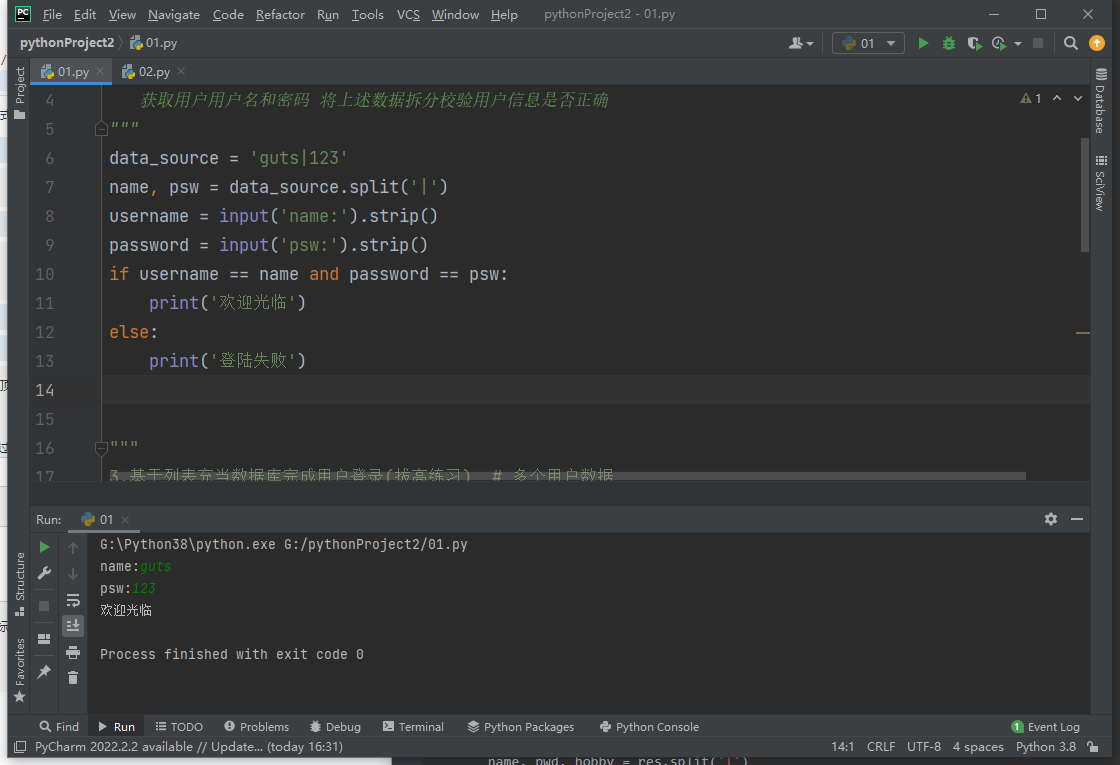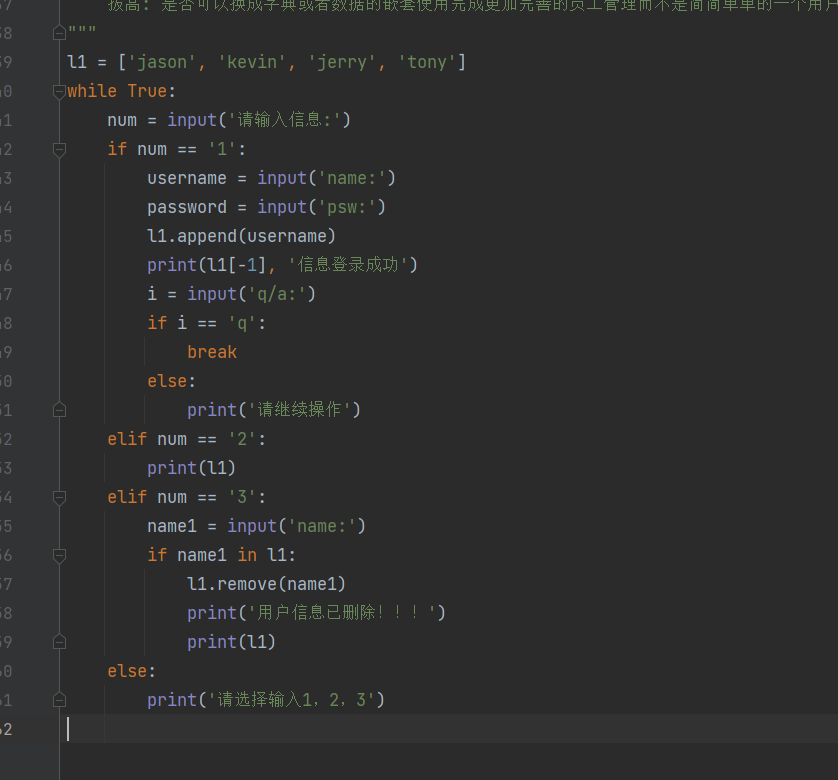python 数据类型内置方法
今日内容概要
- 数据类型的内置方法理论
- 整形相关操作
- 浮点型相关操作
- 字符串相关操作
- 列表相关操作
今日内容详细
数据类型内置方法理论
我们之前所学习的每一种数据类型本身都含有一系列的操作方法,内置方法是其中最多的(自带的功能)
在python中数据类型调用内置方法的统一句式为>>>:句点符
'guts'.字符串内置方法
绑定字符串的变量名.字符串内置方法
str.字符串内置方法
ps:数据类型的内置方法比较的多 我们如果想要掌握 不要光靠死记硬背 更多时候靠的是熟能生巧
整型内置方法与操作
1. 类型转换(将其他数据类型转换成整形)
int(其他类型数据)
ps:浮点型可以直接转换 字符串必须满足内部是纯数字才可以
2.进制数转换
十进制转其他进制
print(bin(100)) #0b1100100
print(oct(100)) #0o144
print(hex(100)) #0x64
'''
数字的开头如果是0b则为二进制 0o则为八进制 0x则为十六进制
'''
其他进制转十进制
print(int(0b1100100))
print(int(0o114))
print(int(0x64))
print(int("0b1100100", 2))
print(int("0o144", 8))
print(int("0x64", 16))
3.python自身对数字的敏感度较低(精确度低)
python这门语言其实真的一点都不厉害 主要是因为他背后有太多的大佬
如果需要精准的计算需要借助与模块numpy....
字符串内置方法与操作
1.类型转换
str(其他数据类型)
ps:可以转任意数据类型(只需要在前后加引号即可)
2.必须要掌握的方法
1.索引取值(起始位置0开始 超出范围直接报错)
s1 = 'hello word'
print(s1[0]) #h
print(s1[-1]) #d 支持复数 从末尾开始
2.切片操作
print(s1[1:5]) # 顾头不顾尾 从索引1一直切到索引4
print(s1[-1:-5]) # 默认的顺序是从左往右 所以不能这么输入
print(s1[-5:-1]) # 默认的顺序是从左往右
3.修改切片方向(间隔)
print(s1[1:5:1]) # 默认是1
print(s1[1:5:2]) # 默认是1
print(s1[-1:-5:-1]) # dlro
print(s1[:]) # 不写数字就默认都要
print(s1[2:]) # 从索引2开始往后都要
print(s1[:5]) # 从索引0开始要到4
print(s1[::2]) # 每隔两个拿一个
4.统计字符串中字符的个数
print(len(s1))
5.移除字符串首尾指定的字符
username = input('username:').strip()
username = username.strip()
if username == 'guts'
print('登陆成功')
res = ' guts '
print(len(res))
print(len(res.strip())) # 括号内不写 默认一处首位空格
res1 = '$$guts$$'
print(res1.strip('$')) # guts
print(real.lstrip('$')) # guts$$
print(real.rstrip('$')) # $$guts
6.切割字符串中的指定字符
res = 'guts|123|study'
print(res.split('|')) # ['guts','123'.'study'] 该方法的处理结果是一个列表
name, pwd, hobby = res.split('|')
print(res.split('|', maxsplit=1)) #['guts'.'123|study'] # 从左往右切指定个数
print(res.rsplit('|', maxsplit=1)) #['guts|123', 'study'] # 从右往左切指定个数
7.字符串格式花输出
format玩法1:等价于占位符
res = 'my name is {} my age is {}'.format('guts',123)
print(res) # 大括号中的数字为.format()中的索引位置
format玩法2:索引取值并支持反复使用
res = 'my name is {0} my age is {1} {0} {0} {1}'.format('guts', 123)
print(res)
format玩法3:占位符见名知意
res = 'my name is {name1} my age is {age1} {name1} {age1} {name1}'
.format(name1='guts',age1=123)
print(res)
format玩法4:推荐使用(**********)
name = input('username:')
age = input('age:')
res = f'my name is {name} my age is {age)'
print(res)
3.字符串需要了解的方法
1.大小写相关
res = 'hElLo WorLd 666'
print(res.upper()) # HELLO WORLD 666
print(res.lower()) # hello world 666
'''图片验证码:生成没有大小写统一的验证码 展示给用户看
获取用户输入的验证码 讲用户输入的验证码和当初生成的验证码统一转大写或小写再比对
'''
code = 'Bja6Cc'
print('展示给用户看到图片验证码',code)
confirm_code = input('请输入验证码').strip()
if confirm_codde.upper() == code.upper():
print('验证码正确')
res = 'hello world'
print(res.isupper()) # 判断字符串是否是纯大写 Flase
print(res.islower()) # 判断字符串是否是纯小写 True
2.判断字符串是否是纯数字
res = ''
print(res.isdigit()) # False
guess_age = input('guess_age>>>:').strip()
if guess_age.isdigit():
guess_age = int(guess_age)
else:
print('年龄都不知道怎么输吗???')
3.替换字符串中指定的内容
res = 'my name is guts guts guts guts'
print(res.replace('guts','tonySB')) # my name is tonySB
print(res.replace('guts','tonySB', 1)) # my name is tonySB guts guts guts 从左往右替换指定个数的内容
4.字符串的拼接
ss1 = 'hello'
ss2 = 'world'
print(ss1 + '$$$' + ss2) # hello$$$world
print(ss1 * 10) # hellohellohellohellohellohellohellohellohellohello
print('|'.join(['guts','123','read','DBJ'])) # guts|123|read|DBJ
print('|',join(['guts',123])) # 参与拼接的数据值必须是字符串
5.统计指定字符出现的次数
res = 'hello world'
print(res.count('l')) # 3
6.判断字符串开头或者结尾
res = 'guts say hello'
print(res.startswith('guts')) # Ture
print(res.startswith('g'))
print(res.startswith('gut'))
print(res.startswith('s')) # False
print(res.startswith('uts')) # False
print(res.endswith('o')) # Ture
print(res.endswith('llo'))
print(res.endswith('hello'))
print(res.endswith('he')) # False
7.其他方法补充
res = 'hello woRLd HeLLo worLD'
print(res.title()) # Hello World Hello World
print(res.capitalize()) # Hello world hello world
print(res.swapcase()) # HELLO WOrlD hEllo WORld
print(res.index('o')) # 所选字符在字符串中的数量
print(res.find('o'))
print(res.index('c')) # 找不到直接报错
print(res.find('c')) # 找不到默认返回-1
print(res.find('lo')) # 索引字符串在字符串中的位置
列表内置方法及操作
1.类型转换
list(其他数据类型)
ps:能够被for循环的数据类型都可以转成列表
print(list('hello'))
print(list({'name':'guts','pwd':123}))
print(list((1,2,3,4)))
print(list({1,2,3,4,5}))
2.需要掌握的方法
l1 = [111, 222, 333, 444, 555, 666, 777]
1.索引取值(正负数)
print(l1[0]) # 111
print(l1[-1]) # 777
2.切片操作 与字符串讲解操作一致
print(l1[0:5]) # [111, 222, 333, 444, 555]
print(l1[:])
3.间隔数 方向 与字符串讲解操作一致
print(l1[::1])
4.统计列表中数据值的个数
print(len(l1)) # 7
5.数据值修改
l1[0] = 123 # 按照索引位置
print(l1)
6.列表添加数据值
方式1:尾部追加数据值
l1.append('干饭')
print(l1) # [123, 222, 333, 444, 555, 666, 777, '干饭']
l1.append(['guts','jason','kevin','jerry'])
print(l1) # [123, 222, 333, 444, 555, 666, 777, ['guts', 'jason', 'kevin', 'jerry']]
方式2:扩展列表 合并列表
ll1 = [11,22,33]
ll2 = [44,55,66]
print(ll1+ll2) # [11, 22, 33, 44, 55, 66]
ll1,extend(112) # for循环+append
print(ll1) # [11, 22, 33, 44, 55, 66]
for i in ll2:
ll1.append(i)
print(ll1) # [11, 22, 33, 44, 55, 66]
7.删除列表数据
方式1:通用的删除关键字del
del l1[0]
print(l1)
方式2:remove
l1.remove(444) # 括号内填写数据值
print(l1)
方式3:pop
l1.pop(3) # 括号内填写索引值
print(l1)
l1.pop() # 默认尾部弹出数据值
print(l1)
res = l1.pop(3)
print(res) # 444
res1 = l1.remove(444) # 直接销毁
print(resl) #None
8.排序
ss = [54, 99, 55, 76, 12, 43, 76, 88, 99, 100, 33]
ss.sort() # 默认是升序
print(ss)
ss.sort(reverse = True)
print(ss) # 改为降序
9.统计列表中某个数据值出现的次数
print(l1.count(111))
10.颠倒列表顺序
l1.reverse()
print(l1)
可变类型与不可变类型
s1 = '$$guts$$'
l1 = [11,22,33]
s1.strip('$')
print(s1) # $$guts$$
'''字符串在调用内置方法之后并不会修改自己 而是产生了一个新的结果
如何查看调用方法之后有没有新的结果 可以在调用该方法的代码左侧添加变量名和赋值符号
res = s1.strip('$')
'''
ret = l1.append(44)
print(l1) # [11,22,33,44]
print(ret) # None
'''列表在调用内置方法之后修改的就是自身 并没有产生一个新的结果'''
可变类型:值改变 内存地址不变
l1 = [11, 22, 33]
print(l1) # [11, 22, 33]
print(id(l1)) # 1470055892864
l1.append(44)
print(l1) # [11, 22, 33, 44]
print(id(l1)) # 1470055892864
不可变类型:值改变 内存地址肯定变
res = '$$hello world$$'
print(res) # $$hello world$$
print(id(res)) # 2089978428912
res1 = res.strip('$')
print(res1) # hello
print(id(res1)) # 2089979738160
作业








【推荐】国内首个AI IDE,深度理解中文开发场景,立即下载体验Trae
【推荐】编程新体验,更懂你的AI,立即体验豆包MarsCode编程助手
【推荐】抖音旗下AI助手豆包,你的智能百科全书,全免费不限次数
【推荐】轻量又高性能的 SSH 工具 IShell:AI 加持,快人一步
· 震惊!C++程序真的从main开始吗?99%的程序员都答错了
· 别再用vector<bool>了!Google高级工程师:这可能是STL最大的设计失误
· 单元测试从入门到精通
· 【硬核科普】Trae如何「偷看」你的代码?零基础破解AI编程运行原理
· 上周热点回顾(3.3-3.9)